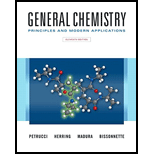
EBK GENERAL CHEMISTRY
11th Edition
ISBN: 9780133400588
Author: Bissonnette
Publisher: VST
expand_more
expand_more
format_list_bulleted
Concept explainers
Question
Chapter 25, Problem 48E
Interpretation Introduction
Interpretation:
The reason for less energy produced in nuclear fission process as compared to the nuclear fusion process needs to be explained.
Concept introduction:
A nuclear fusion reaction takes place when one or more different atomic nuclei are formed by combination of two more atomic nuclei.
The release or absorption of energy differentiates the reactants and the products.
Expert Solution & Answer
Want to see the full answer?
Check out a sample textbook solution
Students have asked these similar questions
First image: I have to show the mecanism (with arows and structures) of the reaction at the bottom. Also I have to show by mecanism why the reaction wouldn't work if the alcohol was primary
Second image: I have to show the mecanism (with arrows and structures) for the reaction on the left, where the alcohol A is added fast in one portion
its not an exam
what is the skeletal structure of a tertiary alkyl fluoride with six carbon atoms and no rings.
One step of glycolysis is a retro-aldol reaction (aldolase) to produce ATP.Below is the aldol reaction of the equilibrium. Show the mechanism for the base catalyzed reaction. *see image
Chapter 25 Solutions
EBK GENERAL CHEMISTRY
Ch. 25 - Prob. 1ECh. 25 - Prob. 2ECh. 25 - Prob. 3ECh. 25 - Prob. 4ECh. 25 - Prob. 5ECh. 25 - Prob. 6ECh. 25 - Prob. 7ECh. 25 - Prob. 8ECh. 25 - Prob. 9ECh. 25 - Prob. 10E
Ch. 25 - Prob. 11ECh. 25 - Prob. 12ECh. 25 - Prob. 13ECh. 25 - Prob. 14ECh. 25 - Prob. 15ECh. 25 - Prob. 16ECh. 25 - Prob. 17ECh. 25 - Prob. 18ECh. 25 - Prob. 19ECh. 25 - Prob. 20ECh. 25 - Prob. 21ECh. 25 - Prob. 22ECh. 25 - Prob. 23ECh. 25 - Prob. 24ECh. 25 - Prob. 25ECh. 25 - Prob. 26ECh. 25 - Prob. 27ECh. 25 - Prob. 28ECh. 25 - Prob. 29ECh. 25 - Prob. 30ECh. 25 - Prob. 31ECh. 25 - Prob. 32ECh. 25 - Prob. 33ECh. 25 - Prob. 34ECh. 25 - Prob. 35ECh. 25 - Prob. 36ECh. 25 - Prob. 37ECh. 25 - Prob. 38ECh. 25 - Prob. 39ECh. 25 - Prob. 40ECh. 25 - Prob. 41ECh. 25 - Prob. 42ECh. 25 - Prob. 43ECh. 25 - Prob. 44ECh. 25 - Prob. 45ECh. 25 - Prob. 46ECh. 25 - Prob. 47ECh. 25 - Prob. 48ECh. 25 - Prob. 49ECh. 25 - Prob. 50ECh. 25 - Prob. 51ECh. 25 - Prob. 52ECh. 25 - Prob. 53ECh. 25 - Prob. 54ECh. 25 - Prob. 55ECh. 25 - Prob. 56ECh. 25 - Prob. 57IAECh. 25 - Prob. 58IAECh. 25 - Prob. 59IAECh. 25 - Prob. 60IAECh. 25 - Prob. 61IAECh. 25 - Prob. 62IAECh. 25 - Prob. 63IAECh. 25 - Prob. 64IAECh. 25 - Prob. 65IAECh. 25 - Prob. 66IAECh. 25 - Prob. 67IAECh. 25 - Prob. 68IAECh. 25 - Prob. 69IAECh. 25 - Prob. 70IAECh. 25 - Prob. 71IAECh. 25 - Prob. 72FPCh. 25 - Prob. 73FPCh. 25 - Radioactive decay and mass spectrometry are often...Ch. 25 - Prob. 75SAECh. 25 - Prob. 76SAECh. 25 - Prob. 77SAECh. 25 - Prob. 78SAECh. 25 - Prob. 79SAECh. 25 - Prob. 80SAECh. 25 - Prob. 81SAECh. 25 - Prob. 82SAECh. 25 - Prob. 83SAECh. 25 - Prob. 84SAECh. 25 - Prob. 85SAECh. 25 - Prob. 86SAECh. 25 - Prob. 87SAECh. 25 - Prob. 88SAECh. 25 - Prob. 89SAECh. 25 - Prob. 90SAECh. 25 - Prob. 91SAECh. 25 - Prob. 92SAECh. 25 - Prob. 93SAE
Knowledge Booster
Learn more about
Need a deep-dive on the concept behind this application? Look no further. Learn more about this topic, chemistry and related others by exploring similar questions and additional content below.Similar questions
- Draw the mechanism (including all curved arrows for electron movement) showing how the maleicanhydride is attacked by the anthracene and formation of the final Diels Alder product.arrow_forwardProvide the missing information. *see imagearrow_forwardProvide the missing information. *see imagearrow_forward
- Provide the missing information. *see imagearrow_forwardI have a bottle of butanal that has been improperly used by lab workers. They allowed a traceamount NaOH (aq) to contaminate the bottle. What is now in my bottle of “butanal? What is the molecular name and functional group name? Draw the structure.arrow_forwardProvide the missing information. *see imagearrow_forward
arrow_back_ios
SEE MORE QUESTIONS
arrow_forward_ios
Recommended textbooks for you
 World of Chemistry, 3rd editionChemistryISBN:9781133109655Author:Steven S. Zumdahl, Susan L. Zumdahl, Donald J. DeCostePublisher:Brooks / Cole / Cengage LearningChemistry: Matter and ChangeChemistryISBN:9780078746376Author:Dinah Zike, Laurel Dingrando, Nicholas Hainen, Cheryl WistromPublisher:Glencoe/McGraw-Hill School Pub Co
World of Chemistry, 3rd editionChemistryISBN:9781133109655Author:Steven S. Zumdahl, Susan L. Zumdahl, Donald J. DeCostePublisher:Brooks / Cole / Cengage LearningChemistry: Matter and ChangeChemistryISBN:9780078746376Author:Dinah Zike, Laurel Dingrando, Nicholas Hainen, Cheryl WistromPublisher:Glencoe/McGraw-Hill School Pub Co Chemistry: Principles and PracticeChemistryISBN:9780534420123Author:Daniel L. Reger, Scott R. Goode, David W. Ball, Edward MercerPublisher:Cengage Learning
Chemistry: Principles and PracticeChemistryISBN:9780534420123Author:Daniel L. Reger, Scott R. Goode, David W. Ball, Edward MercerPublisher:Cengage Learning General, Organic, and Biological ChemistryChemistryISBN:9781285853918Author:H. Stephen StokerPublisher:Cengage Learning
General, Organic, and Biological ChemistryChemistryISBN:9781285853918Author:H. Stephen StokerPublisher:Cengage Learning Chemistry: The Molecular ScienceChemistryISBN:9781285199047Author:John W. Moore, Conrad L. StanitskiPublisher:Cengage Learning
Chemistry: The Molecular ScienceChemistryISBN:9781285199047Author:John W. Moore, Conrad L. StanitskiPublisher:Cengage Learning

World of Chemistry, 3rd edition
Chemistry
ISBN:9781133109655
Author:Steven S. Zumdahl, Susan L. Zumdahl, Donald J. DeCoste
Publisher:Brooks / Cole / Cengage Learning

Chemistry: Matter and Change
Chemistry
ISBN:9780078746376
Author:Dinah Zike, Laurel Dingrando, Nicholas Hainen, Cheryl Wistrom
Publisher:Glencoe/McGraw-Hill School Pub Co

Chemistry: Principles and Practice
Chemistry
ISBN:9780534420123
Author:Daniel L. Reger, Scott R. Goode, David W. Ball, Edward Mercer
Publisher:Cengage Learning


General, Organic, and Biological Chemistry
Chemistry
ISBN:9781285853918
Author:H. Stephen Stoker
Publisher:Cengage Learning

Chemistry: The Molecular Science
Chemistry
ISBN:9781285199047
Author:John W. Moore, Conrad L. Stanitski
Publisher:Cengage Learning